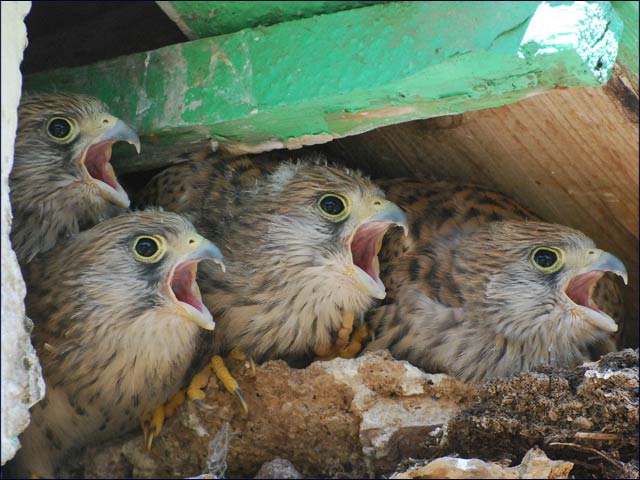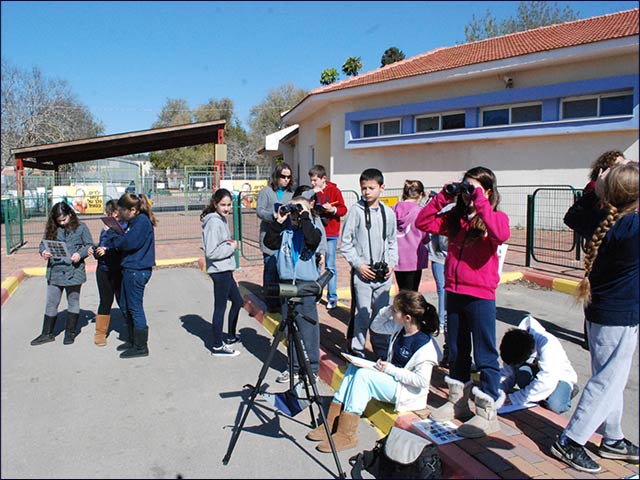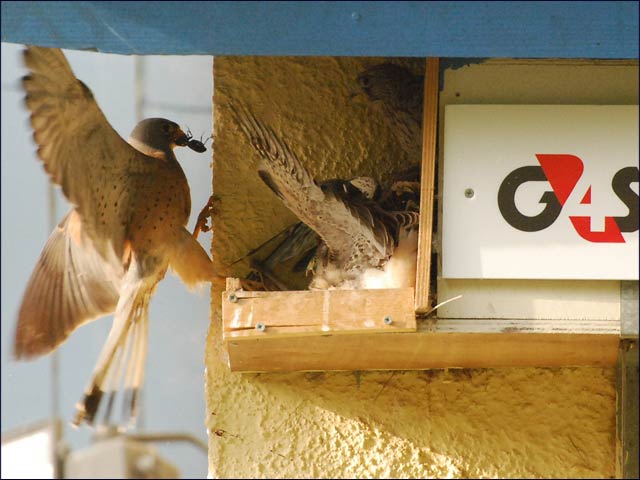By Desmond Bentley
The lesser kestrel (Falco naumanni), a beautiful small falcon that breeds in the Mediterranean basin and migrates from southern Africa across central Asia to China, is a globally threatened species.
The bird was a common summer breeder in Israel until the mid-20th century, with an estimated 2,000 to 3,000 breeding pairs in several major colonies. Yet fewer than 550 pairs now breed in Israel, according to an Israel Ornithological Center Breeding Survey.
“If only we knew the reasons,” sighs Kibbutzim College ecologist and biologist Dr. Adiv Gal.
“There’s been a drastic drop worldwide in the last 50 to 60 years. The decline has slowed down in recent years, but not in Israel,” he says.
Gal heads a unique high school project to preserve a local population of the birds. Students at the Alona Regional School in Moshav Amikam, in central Israel, are trying to reinvigorate the population by protecting their nesting grounds, installing custom-designed nesting boxes, looking after the nestlings and treating injured birds.
A 16-year effort
According to the last complete survey, conducted in 2000, there were 566 nesting pairs in Israel, 109 of them at Alona. Others were found in Greater Tel Aviv, Jerusalem, Megiddo and Safed. However, a local survey last year found only 29 nesting couples in Alona.

Some 29 nesting pairs in Alona are giving birth
to the next generation of lesser kestrel
“The children in this project don’t only study the birds -- they actively help them by building nesting boxes,” says Gal. “This has proved very successful. Of 29 nesting couples this year, 13 are in our boxes.”
The project began in 1996 when Tirza Keren, a mother of children in the school and an amateur birdwatcher herself, approached the local council with the idea. With the council’s backing, she took a class of fifth-graders out into the birds’ habitat, where they began observing and documenting the nesting season.
The studies continued throughout the year and into the next. Sixteen years later, another generation of Alona schoolchildren has become knowledgeable about the red kestrel, even taking students from other schools on end-of-nesting-season guided tours.
“The school, local council and the community are partners, which is why it’s been so successful over the years,” says school principal Shalom Terem. “It’s a great educational project for our students. The children – and their parents -- are proud of this project.” It’s also backed by the Society for the Protection of Nature in Israel.

Children in the Alona Regional School have been learning
about kestrels for the past 16 years
“No similar project has continued at one school for 16 years, and it’s going as strong as ever. Much of this is thanks to Shalom,” says Gal, whose doctoral thesis was on the lesser kestrels of Alona and the Jerusalem area.
“These birds are part of my life,” he says. “I’ve been with them since 1999. Before Tirza passed away in 2005 from cancer, she asked me to take over.”
“We want to reach out to other schools abroad, to invite them to visit us and coordinate [wildlife preservation] projects,” says Gal, noting that many of the school’s students are English speakers.
Watch the nest online
Can such projects really make a difference?
“Certainly for the children,” says Gal. “It’s far more important from an educational perspective than in terms of the birds themselves.”
The project’s biggest innovation in recent years has been the installation of four video cameras near nesting boxes, donated by the G4S security company, for live broadcasting via the Internet.

A lesser kestrel bringing breakfast for babies
in a nesting box the children built
Monitoring the birds’ movements and populations is no simple matter, says Gal. “They are too small to attach transmitters to them. Tagging is not efficient.”
Several hypotheses have been raised to explain the population decline. The main cause appears to be a food shortage resulting from intensified agriculture and urban sprawl. With fewer foraging grounds, lesser kestrel colonies are increasingly being abandoned.
According to BirdLife International, the Western European population of these falcons has plummeted by 95 percent since 1950, while the South African wintering population has halved since 1971. The worldwide population has decreased by more than 20% in the past decade.
The lesser kestrel builds no nest structure, preferring to colonize crannies of buildings, cliffs or trees, laying three to six eggs at a time. A bird of prey, it eats insects, small birds, reptiles and rodents (especially mice).
Every February, fewer kestrels complete their journey from Africa to the breeding grounds in the Alona area. The males arrive first, to find a suitable nesting place. The females arrive soon after, to mate and nest.
“They used to nest in the space between roof slats, but nowadays roofs are built straight on the concrete walls, without a gap for them to utilize,” explains Gal.
“In Jerusalem the problem appears to be one of food availability. In Alona they can become the prey of cats and owls. In any case, there appear to be fewer arriving from Africa,” says Gal. “We don’t yet know the exact situation this year – but can only guess that it’s not good.”